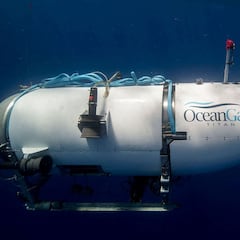The Titan tragedy came some two years after the OceanGate submersible had made its first visit to the wreckage of the Titanic, on the Atlantic seafloor.

How many expeditions did OceanGate submersible make to see Titanic? When were they?
On June 18, 2023, five people were killed when the Titan, a submersible built and operated by the company OceanGate Expeditions, imploded on a dive to visit the wreckage of the Titanic. Four days after the Titan lost contact with its support ship, debris from the underwater vessel was found some 1,600 feet from the Titanic, which sits on the Atlantic seafloor at a depth of around 12,500 feet.
How deep was Titan designed to go?
OceanGate had been carrying out deep-ocean expeditions since 2009. Over the years before the tragedy it had conducted more than 200 dives with its three submersible vessels in the Atlantic, Pacific and Gulf of Mexico. The Titan was designed to go the deepest of them all, able to reach depths of over 13,000 feet, according to the company.
And this wasn’t the vessel’s first trip to the Titanic. Earlier expeditions had been planned as far back as 2018, but technical and regulatory snags had prevented them from being carried out. It wasn’t until 2021, then again in 2022, that the Titan made the first of several dives to the most famous shipwreck in the world. While generally successful, those expeditions hadn’t been without their own problems. This fatal dive was the vessel’s 14th trip to the remains of the Titanic.
Titan submersible remains: Everything we know a year later https://t.co/w0l49s6SWF pic.twitter.com/mP3FyYD53w
— Newsweek (@Newsweek) June 18, 2024
Concerns raised about OceanGate’s Titan sub
OceanGate chief executive, Stockton Rush, who was on this occasion, as was often the case, piloting the submersible, would explain to passengers that the Titan’s pressure vessel, made of carbon fiber and titanium, was designed with NASA and the University of Washington during a pre-voyage tour.
However, much of the rest of the structure, the handles, lights and propellers were off-the-shelf parts, including it being controlled by a Playstation controller, David Pogue, CBS correspondent and former Titan passenger explained. This is because they are tried and tested in addition to lowering the cost of construction as they are mass produced. Pogue for his part says that he felt okay once the capsule was bolted shut, “I felt like they wouldn’t do this if it was really dangerous.”
CBS reporter David Pogue and the Simpsons writer Mike Reiss describe what it was like inside the Titan, the missing submersible which disappeared while taking tourists to see the wreckage of the Titanic https://t.co/rHr3lBSspC pic.twitter.com/2I2p5cuzt9
— Reuters (@Reuters) June 21, 2023
In 2018 though, alarms about the Titan were sounded both inside and outside the company the New York Times reports. David Lochridge, the director of marine operations at OceanGate Expeditions, wrote a scolding report calling for more testing of the vessel. Shortly thereafter more than three dozen experts warned Rush in a letter about the company’s “experimental” approach to testing and stressing the Titan.
Related stories

Remembering the five aboard the Titan submersible

Map shows where the remains of the Titan lay
They called on OceanGate Expeditions to have the sub undergo a traditional assessment by a leading certified organization, one which the company was “unwilling to pay” according to court documents in a legal battle with Lochridge. In those documents, the director of marine operations had learned that the viewport for the Titan was only certified up to 1,300 meters less than a third of what would be needed to reach the Titanic. However, Arron Newman, four-time passenger on the Titan and shareholder in OceanGate, which built and operates the Titan submersible, told MSNBC’s Ali Velshi that vessel had been a prototype.
In 2019, submersible expert Karl Stanley, sent an email to the Titan’s creator Stockton Rush after hearing cracking noises during a dive aboard the vessel. During his 12,000 foot descent, with Rush piloting, the sounds got louder the further down they went.

Complete your personal details to comment